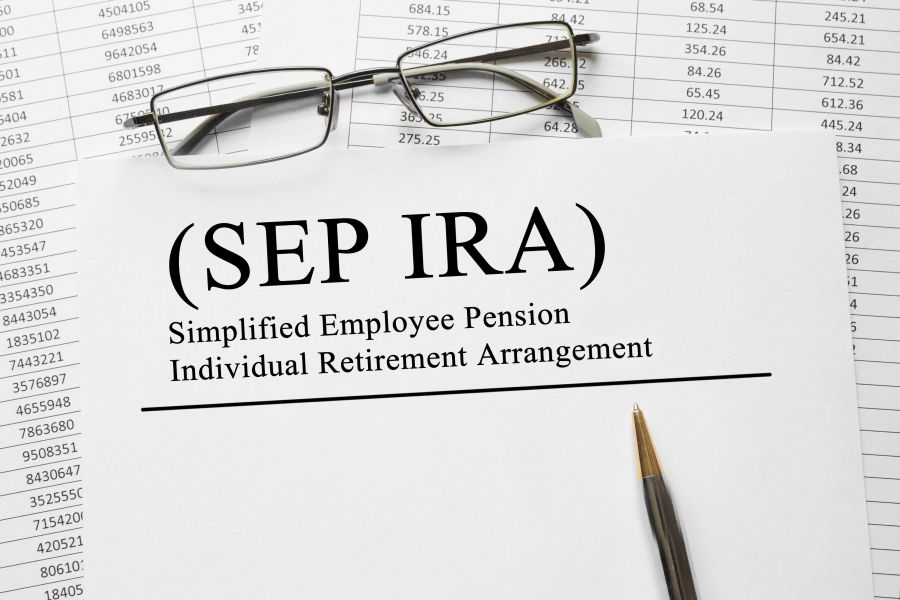Deciding between an IRA and a 401(k) can feel overwhelming when planning for retirement. This guide breaks down the key features, benefits, and limitations of each option to help you decide where to start saving.

Did you know that employer 401(k) contributions can double your investment instantly? Meanwhile, IRAs provide unmatched flexibility for diversifying your nest egg. Let’s explore which option might be the right fit for your financial goals.
IRA vs. 401(k): Which suits your retirement goals better?
It’s a matter of personal preference. But the most important goal is maximizing your dollar. Here are some useful tips to help you decide:
Start with Your 401(k)
A 401(k) is often the best place to start saving for retirement, especially if your employer offers a matching contribution. Employer matching is essentially free money that boosts your savings instantly. Here’s how it works:
For example, if you earn $50,000 a year and your employer matches 100% of your contributions up to 5%, contributing $2,500 means your employer adds another $2,500. That’s $5,000 saved for retirement—double what you initially invested.
Contribution limits are also generous. In 2024, you can contribute up to $23,000 annually if you’re under 50, or $30,000 if you’re 50 or older. This makes it a powerful tool for maximizing your savings while lowering your taxable income.
Move on to Your Traditional IRA
If you’ve maxed out your 401(k) contributions or your plan’s investment options feel limited, a traditional IRA is a great next step. It allows you to diversify your retirement savings with access to a broader range of investment choices, including stocks, bonds, and mutual funds.
One of the key benefits of a traditional IRA is the tax advantage. Contributions reduce your taxable income for the year, which can lower your tax bill immediately. For example, if you contribute $6,500 and fall into the 22% tax bracket, you could save $1,430 on taxes. This makes it a smart option for building wealth while enjoying tax relief.
Consider a Roth IRA
A Roth IRA offers unique tax benefits that can be advantageous for your retirement strategy. Since contributions are made with after-tax dollars, qualified withdrawals in retirement are entirely tax-free. This can be especially beneficial if you anticipate being in a higher tax bracket later on or if tax rates increase.
However, eligibility to contribute to a Roth IRA depends on your income. For 2024, the contribution limits are as follows:
- Single filers: Full contribution allowed if your modified adjusted gross income (MAGI) is less than $146,000. The contribution limit phases out between $146,000 and $161,000. Above $161,000, you’re not eligible to contribute directly to a Roth IRA.
- Married filing jointly: Full contribution allowed if your MAGI is less than $230,000. The contribution limit phases out between $230,000 and $240,000. Above $240,000, direct contributions aren’t permitted.
If your income exceeds these limits, you might consider a “backdoor” Roth IRA conversion, which involves contributing to a traditional IRA and then converting those funds to a Roth IRA. This strategy can be complex, so it’s wise to consult a financial advisor to ensure it aligns with your financial goals and to understand the tax implications.
Comparing Key Features of 401(k), Traditional IRA, and Roth IRA
When choosing a retirement account, comparing key features side by side can make the decision easier. Here’s a breakdown:
| Feature | 401(k) | Traditional IRA | Roth IRA |
|---|---|---|---|
| Tax Treatment | Pre-tax | Pre-tax | Post-tax |
| Contribution Limits | $22,500 ($30,000 if 50+) | $6,500 ($7,500 if 50+) | $6,500 ($7,500 if 50+) |
| Withdrawal Taxes | Taxable | Taxable | Tax-free |
| Employer Match | Yes | No | No |
Quick Tip: Start with your 401(k) if your employer offers matching contributions—it’s free money! Once you’ve maximized your match, consider a traditional or Roth IRA for additional savings flexibility or tax benefits.
How to Maximize Your Retirement Strategy
To build a strong nest egg, it’s essential to make the most of your available retirement accounts. Here’s how to approach it:
- Start with Employer Matching: Contribute enough to your 401(k) to receive the full employer match. This ensures you’re taking advantage of free money and growing your savings efficiently.
- Expand with an IRA: If you still have room to save, open an IRA. Choose a traditional IRA for immediate tax savings or a Roth IRA for tax-free withdrawals in retirement.
- Diversify Your Investments: Use your IRA to access investment options not available in your 401(k), like individual stocks, ETFs, or mutual funds.
- Review Your Plan Regularly: Check your accounts periodically to ensure your savings align with your retirement goals. Adjust contributions or investments as needed.
By balancing multiple accounts, you can optimize tax advantages, diversify your portfolio, and create a more secure financial future.
Common Mistakes to Avoid
When saving for retirement, even small missteps can have significant long-term effects. Here are common pitfalls to watch out for:
- Skipping the Employer Match: Not contributing enough to get your employer’s full 401(k) match is like leaving free money on the table.
- Ignoring Fees: High fees in 401(k) plans or IRAs can eat into your savings. Compare options to minimize costs.
- Failing to Diversify: Sticking with limited 401(k) investments without exploring IRA options can hinder portfolio growth.
- Withdrawing Early: Taking money out before retirement leads to penalties and lost compounding growth.
- Overlooking Tax Planning: Failing to consider the tax implications of your account choices can lead to unexpected bills in retirement.
Avoiding these mistakes can keep your retirement strategy on track and maximize the value of your savings.
Retirement Planning for Self-Employed Individuals
If you’re self-employed, you don’t need to miss out on powerful retirement savings tools. Here are options designed for entrepreneurs and freelancers:
- SEP IRA: Simplified Employee Pension IRAs allow you to contribute up to 25% of your net earnings, with a limit of $66,000 for 2024. Contributions are tax-deductible, reducing your taxable income.
- Solo 401(k): Perfect for business owners with no employees, Solo 401(k)s allow contributions as both employer and employee. The total limit is $66,000 ($73,500 if 50 or older) for 2024.
- Roth IRA: If your income is within the limits, a Roth IRA offers tax-free withdrawals and is a great complement to other self-employed options.
- Traditional IRA: If you prefer immediate tax savings, a traditional IRA can help reduce your taxable income.
By exploring these options, self-employed individuals can build a retirement strategy that rivals traditional workplace plans.
Bottom Line
Your choice between an IRA and a 401(k) should align with your financial priorities and future goals. If an employer match is available, take full advantage of it to grow your savings faster. Beyond that, use IRAs to expand your investment options or balance immediate tax benefits with long-term savings. The most important step is to start now and revisit your strategy regularly to ensure you’re on track for a secure retirement.
Frequently Asked Questions
Can I contribute to both a 401(k) and an IRA in the same year?
Yes, you can contribute to both as long as you stay within the annual contribution limits for each account. However, the tax deductibility of traditional IRA contributions may depend on your income and participation in a 401(k).
Which is better: a Roth IRA or a traditional IRA?
It depends on your tax situation. A traditional IRA is better if you want to reduce your taxable income now. A Roth IRA is ideal if you expect to be in a higher tax bracket at retirement, as withdrawals are tax-free.
What happens if I withdraw money from my 401(k) or IRA early?
Early withdrawals from a 401(k) or traditional IRA are generally subject to a 10% penalty and income taxes unless you qualify for specific exceptions, like buying a first home (IRA) or financial hardship (401(k)).
Are employer 401(k) matches included in the contribution limit?
No, employer matches are not included in your annual 401(k) contribution limit. For 2024, you can contribute up to $23,000 (or $30,000 if 50 or older), and employer contributions are in addition to this limit.
Can self-employed individuals open a Roth IRA?
Yes, self-employed individuals can open a Roth IRA if their income falls within IRS limits. For 2024, single filers with a modified adjusted gross income below $146,000 can contribute the full amount. Contributions phase out between $146,000 and $161,000.
What’s the difference between a Solo 401(k) and a SEP IRA?
A Solo 401(k) allows contributions as both an employer and employee, leading to higher limits. A SEP IRA focuses solely on employer contributions, up to 25% of net earnings, making it simpler to manage.
Should I prioritize paying off debt or contributing to retirement savings?
It depends on your debt and financial goals. High-interest debt, like credit cards, should be paid off first. However, contribute enough to your 401(k) to get your employer’s match, as it’s essentially free money.
Are Roth IRA contributions tax-deductible?
No, Roth IRA contributions are made with after-tax dollars and are not tax-deductible. The benefit is that qualified withdrawals in retirement are entirely tax-free.
Is it possible to roll over a 401(k) to an IRA?
Yes, you can roll over a 401(k) to a traditional or Roth IRA if you leave your job or retire. This gives you more control over your investments while maintaining tax advantages.
How often should I review my retirement accounts?
You should review your retirement accounts at least once a year. Check your contribution levels, investment performance, and fees to ensure your strategy aligns with your retirement goals.




